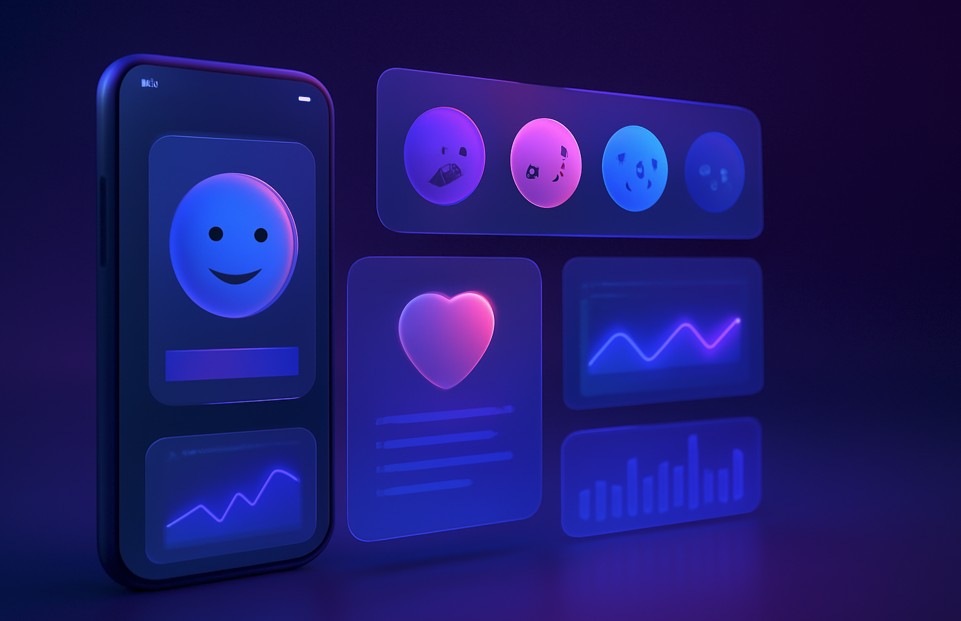Your App Doesn’t Just Need to Be Smart, It Needs to Feel
Have you ever used an app that technically worked but somehow felt cold, robotic, or frustrating?
Now imagine a digital experience that senses your frustration, adapts its tone, or changes its flow based on your emotional state, instantly making you feel understood.
This isn’t science fiction. This is Emotionally Intelligent AI (EI-AI), the next frontier of User Experience (UX) where machines not only respond but also empathize.
In a hyper-competitive digital landscape, businesses can no longer afford to build products that only function. The future lies in building products that connect on an emotional level.
What Is Emotionally Intelligent AI?
Emotionally Intelligent AI refers to systems that can recognize, interpret, and respond to human emotions in real-time. This is made possible through:
-
Facial expression analysis
-
Voice tone recognition
-
Text sentiment analysis
-
Behavioral pattern tracking
-
Biometric sensors (in some cases)
The goal? To build apps and interfaces that adapt, just like a human would, to how a user feels.
Why Emotional Intelligence Matters in UX
Traditional digital interfaces treat all users the same, but emotional AI personalizes the experience in real-time, increasing:
-
Engagement
-
Trust
-
Retention
-
Conversion rates
In fact:
-
75% of users say they’re more likely to stay on apps that feel “more human”
-
62% of consumers are open to AI if it improves emotional connection (source: PwC)
-
Emotional design can increase product adoption by up to 47% (source: Nielsen Norman Group)
Table: Traditional UX vs Emotionally Intelligent UX
| Feature | Traditional UX | Emotionally Intelligent UX |
|---|---|---|
| User Input Type | Clicks, taps, gestures | Emotions, expressions, tone |
| Personalization Level | Static or rule-based | Real-time emotional adaptation |
| Feedback Loop | One-way | Bi-directional, empathetic |
| Interaction Tone | Neutral or scripted | Context-aware, emotionally tuned |
| Experience Outcome | Functional | Human-centered & intuitive |
How Emotionally Intelligent AI Works
1. Emotion Detection
Using NLP and computer vision, the system detects user sentiment from facial cues, tone of voice, or written language.
2. Contextual Understanding
The AI maps the emotion to the user journey e.g., frustration during a checkout process or joy after achieving a goal.
3. Dynamic Response
Based on that insight, the app adapts, changing content tone, offering help, delaying a push notification, or simplifying the UI.
Real-World Applications
-
E-Learning Platforms: Adapt the difficulty level or offer encouragement if a student seems frustrated.
-
Healthcare Apps: Offer emotional support or connect to a real counselor when distress is detected.
-
E-commerce: Recommend mood-aligned products or change the UI tone (e.g., cheerful colors for happy users).
-
Customer Support: Bots that escalate issues when anger or confusion is sensed, reducing churn.
Benefits of Emotionally Intelligent UX
1. Increased Engagement
Users feel understood, leading to longer sessions and repeat usage.
2. Improved Conversions
Adaptive UX flows reduce friction, especially during high-stress interactions like checkouts or support.
3. Stronger Brand Loyalty
When users feel an app “gets them,” emotional loyalty kicks in.
4. Deeper Data Insights
Understanding emotional behavior gives brands a deeper, more human picture of their users.
Challenges to Address
While emotionally intelligent AI is powerful, it comes with real responsibilities:
-
Privacy Concerns: Users must know how their data, especially emotional signals is being used.
-
Bias in Emotion Detection: Models must be trained on diverse datasets to avoid cultural or racial misinterpretations.
-
Over-personalization Risks: Making things “too” tailored can feel intrusive or manipulative.
Transparency, ethical design, and user control are essential for trust.
The Future of Digital UX Is Human-Centric
With AI becoming a core part of digital products, emotionally intelligent interfaces are not just an upgrade, they’re a necessity. As users demand more meaningful interactions, the ability to recognize and respond to emotional states becomes a game-changer.
Brands that embrace emotionally intelligent AI will go beyond satisfying users; they’ll build relationships.
Final Thoughts
The future of UX isn’t just smart, it’s emotionally aware.
In a world saturated with cold interfaces, the winners will be those who build apps that listen, feel, and respond like a true companion.

